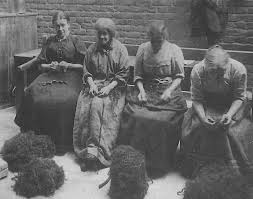
(click on heading to leave comments at bottom of page)
I was writing about Mary Ann’s character in a recent blog. Most of the revealing information comes from the reports made about her while she was serving her sentence in Van Diemen’s Land after she had been sentenced to 7 years’ transportation in 1834.
The surgeon’s report on the journey out was simple. ‘Good’ he wrote, which indicates that she was well-behaved and gave no trouble, unlike some. It was in their interest to earn a positive reference on the voyage because this would determine, to some degree, how they would be treated when they arrived.
She was assigned initially to a Mr Kearns in Launceston but, on 4th March 1836 the first indication of her spirit appeared in the record when she was imprisoned for 1 month in the Crime class of Launceston’s house of correction for being absent without leave. (The inmates were sectioned off into different areas depending on the severity of their misdemeanours and the Crime class was the most serious).
Life in the Crime class was more arduous. For example the women and girls could be set to picking oakum. Now, that doesn’t sound like much of a chore, but it was not a pleasant activity. Oakum is hemp fibre, loosely twisted together and mixed with tar. Its primary use in the 19th century was to make ropes or seal seams in wooden boats. Of course oakum can be made from virgin hemp but a cheaper way is to unpick old ropes and in the female factories this was a punishment deemed more suitable for the tender sex than the treadmill or breaking rocks.
Picking oakum gets harder and harder as you go on. Mary Ann would have been working with tough, old rope, compacted and frayed. It was dirty, covered in grease and grime. First she would have tussled with the solid mass to separate the old rope into plies (most rope is made in a series of plies), then she would have broken it down into singles. Then she’d seperate the singles by picking them apart with broken fingernails down to individual fibres.
In all likelihood she spent hour after hour at this boring job. But the boredom was the least of her problems. Oakum pickers developed thick black, tarred scars on their hands and developed tendonitis, bursitis, nerve damage, and all the conditions that arise from repetitive stress motions.
Yet despite such activity and, later periods in a dark, dank cell in solitary isolation on bread and water for further perceived misdemeanours such as refusing to work, going absent without leave, disobedience and insolence, Mary Ann kept bucking the system. Her sentence was even extended to 8 years because of her continual resistance. She seemed to have an indomitable spirit that refused to be quashed by the system.
I find the fact that Mary Ann came through this episode with her spirit unbowed a tremendous tribute to her and her ability to rise above the darkness of despair.
Despite life having improved for many people in the intervening years, the daily news that parades across our screens and newspapers makes it abundantly clear that many, too many, people still have many miles to go to escape difficult, perhaps hopeless conditions. The protests in the USA and Hong Kong and similar events around the world are witness to the flame that will not be extinguished in the human spirit. Long may it burn brightly.
The post The Human Spirit first appeared on David Cairns of Finavon.